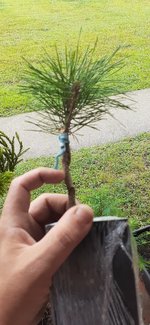When doing difficult things, size matters. We have ordinarily healthy trees that we lose every year to a long list of problems, and when you add the vagaries of the major trauma of big chops and air or ground layers of large trunks, the odds tilt in the wrong direction every time. It can be done, but that doesn't take into consideration that the artistic aspects of covering ugly and/or large holes/stumps is a horse of a different color, it's another, different skill set often absent. Everything takes teaching, time and practice. If a large chop is a first attempt, it is not going to end well. Nothing is ever as easy as it first appears. Worse yet, expecting to be successfully coached via a half dozen paragraphs is like believing in magic.
There is an ugly truth I need to spit out, too. The kinds of skill sets held by people who find themselves with ugly trees that need layers and layers of major recombobulation is inversely proportional to the kinds and levels of skill sets possessed by them. The most important skill that newbees can acquire early in the game is "how to shop" for stock that can actually be turned into bonsai by wire and clip & grow. If a body can't buy the right stock, then they can't fix bad stock either. That IS a flat statement. If they use bad purchases to learn what not to buy, then it's money well-spent. If they think that you can convert bad stock into great trees then they're still too inexperienced to do it. Doing it can be done but it's never worth the effort which is why the experienced don't bother trying. That same amount of time and energy used on good stock is so much more rewarding that it's silly to compare the two outcomes. Newbees should be restricted to buying 1 gallon trees until they show the good sense to not buy stock of grafted, inverse taper, too-many-individuals-crammed-into-one-pot, pretty canopies that cover useless lower wood, ad infinitum. Many people will not develop "the eye" to see the good in a tree, even in their lifetime in bonsai, much less early in the process. Learn to shop. Practice on cheap. Throw away bad choices. There will be plenty of opportunities to learn tricks on small stock that can be up-sized, later. Looking for a quick way to good, big bonsai? Perish the thought.


